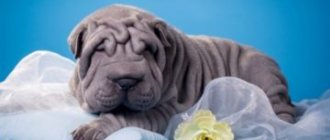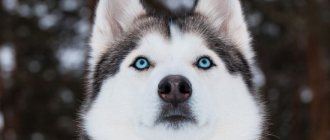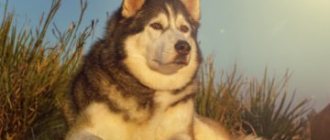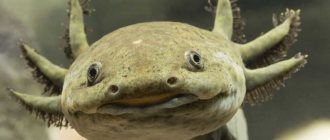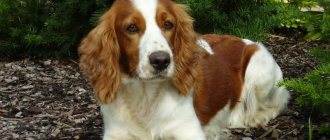The Miniature Schnauzer is a sweet, compact breed that is loved by police officers and customs officers. Despite its miniature size, the dog has a formidable disposition. Therefore, education and training should be done from the first months. There are certain breed standards and owners of miniature dogs can compete in competitions.
Miniature puppy - miniature dog
History of the Miniature Schnauzer breed
Miniature Schnauzer
It is reliably known that the historical homeland of Miniature Schnauzers is Germany. Presumably their ancestors are German Pinschers, a breed of ancient origin. These medium-sized dogs were famous for their ability to mercilessly destroy small rodents, especially rats, and had excellent protective qualities. It is known that initially in the litter of German Pinschers there were smooth-haired and wire-haired puppies. Since the middle of the 19th century, breeders began to subject the offspring of pinschers to separation. Smooth-haired dogs continued to be called pinschers, while wire-haired dogs were called stable pinschers or rattlers. The latter soon acquired the name – schnauzers, which translated from German means “muzzle”. It pointed to an expressive feature of their appearance - a muzzle with a beard, which has a rectangular shape. In 1895, the Pincher Schnauzer Club was created in Cologne, the organizers of which approved standards, including for schnauzers.
Many enthusiastic breeders became interested in the new breed, and soon they began breeding work to create miniature schnauzers, which they called miniature schnauzers. In German, "zwerg" means "gnome". According to one version, in addition to the schnauzer itself, small breed dogs were involved in the creation of the breed: Affenpinschers, miniature pinschers, poodles, Spitz, and possibly some breeds of terriers. The opinion that miniature schnauzers appeared solely due to the crossing of the smallest individuals of schnauzers is denied by most dog experts, since the first miniature schnauzers were completely black, which confirms the participation of at least representatives of Affenpinschers in the miniaturization of dogs.
Miniature Schnauzer puppies
The goal of the breeders was to breed a miniature breed of dog that would have the character and temperament of a Schnauzer and at the same time be suitable for living in urban environments and capable of becoming a companion for its owners. The main initiator of the creation of the new breed was a German breeder, a passionate fan of pinschers and schnauzers, and chairman of the Pincherschnauzer Club - Joseph Bertha.
In 1902, the Pincher Schnauzer Club published its first stud book, where, in addition to Pinschers and Standard Schnauzers, 14 Miniature Schnauzers also found their place. The first official representative of this breed is a male named Jokkio Fulda Liliput, born in 1898.
Already in the 30s of the last century, miniature schnauzers became popular both in Western Europe and overseas - in the USA and Canada. The first two representatives of this breed, which appeared in Russia in 1974, were from the United States. However, mostly miniature schauzers were brought to the territory of the former USSR from Czechoslovakia, where their planned breeding began in 1962. In 1978, Czechoslovak border guards, who used miniatures as service dogs, presented a “batch” of their pets to their Lviv colleagues. From the Lvov nursery, miniature schnauzers, with twists and turns, fell into the hands of first Moscow and then Leningrad cynologists. The “special operation” even required official permission from the USSR Ministry of Internal Affairs. Most of today's Russian miniature schnauzer champions, to one degree or another, retain the genes of their “service” ancestors from Czechoslovakia.
Key facts
The Miniature Schnauzer translates from German as “barbel gnome,” or “whiskered face,” and the dog lives up to its name, being the smallest working breed in the world.
As a service dog, miniatures are used mainly by drug and explosives departments, in which the dogs are helped by their outstanding sense of smell and excellent intuition. The description of the Miniature Schnauzer breed states that the dogs, in addition to their service qualities, have well-developed hunting and guarding skills.
The miniature himself, despite his miniature size, is ready to loyally protect his family with all the seriousness of a large service dog. Or herd sheep - he can do that too.
The Miniature Schnauzer is an excellent companion, he loves children and will be a wonderful play partner for them. They are suitable for both apartment living and living in your own home.
Miniature Schnauzers are very active dogs and show good results in sports. The characteristics of the Miniature Schnauzer breed add to this that the dog requires a good walk.
Like any dog, especially a service dog, a miniature dog must be trained, socialized and educated.
Miniature Schnauzers are very healthy dogs; usually, diseases begin to appear only in old age. The life expectancy of a miniature schnauzer is very high. But in terms of care, this breed is quite labor-intensive. If you want to see your pet beautiful, you will have to regularly cut it, trim it or contact a professional groomer, especially if you have a show dog.
Miniatures have only four generally recognized colors: black, pepper and salt, black and silver and white. In some countries, dogs of unrecognized colors are bred.
The breed is one of the ten most popular in the world because of its easy-going, cheerful character even in old age, its willingness to keep company and take part in any adventures of its owner.
Appearance of miniature schnauzers
Adorably tough miniature schnauzer
The Miniature Schnauzer is a strong, stocky, muscular dog. He looks important, proud, and his shaggy eyebrows give his appearance a serious severity - such an appearance contrasts with the diminutiveness of the miniature, which invariably makes him smile.
Frame
A feature of the Miniature Schnauzer's body is its high front part, and the back line is inclined from the withers to the hindquarters. This can be noticed even in a one-month-old puppy. This addition helps the miniature to develop greater speed when running. The lumbar part of the body is short, giving the dog a compact appearance and a square shape. The sternum is powerful. As it transitions to the groin, the rib cage forms a graceful arched line.
Neck
Medium length, strong, muscular. Nobly curving, it smoothly passes into the withers.
Head
The miniature's head is proportional to the body, narrowing from the ears to the eyes, and then to the tip of the nose. The skull is strong, the occipital protuberance is absent. The forehead is flat and smooth, the transition line from the frontal part to the nose is emphasized by expressive eyebrows. The muzzle is blunted, it is turned away by a bristly short mustache and beard. The nose is black with wide nostrils.
Jaws, teeth, lips
The Miniature Schnauzer's cheekbones are moderately developed, the jaws are powerful, and the bite is perfect and scissor-shaped. The miniature's teeth should be white and strong. The incisors are arranged strictly in a row. Smooth, black lips fit closely to the jaws, their corners are closed.
Ears
The V-shaped ears of the miniature are set high, the tips are bent downwards, towards the temples. The front lower edges of the ears are slightly adjacent to the cheeks.
Eyes
The Miniature Schnauzer's eyes are small, dark in color, and oval-shaped. The look is always lively, curious, expresses vigilance, convincing that the dog is always on the alert. The eyelids should be dry and tightly adjacent to the eyeball.
Miniature Schnauzer muzzle
Limbs
The forelimbs are strong, straight, muscular. The ulna bones protrude neither in nor out. The hind limbs appear slanted when viewed from the side. Set back, they give the dog's body a rapid, dynamic outline. The lower legs are elongated, with well-developed muscles, and merge into strong hock joints. The paws are round in shape, the toes are short and arched (the so-called cat's paw). The claws are black and short.
Movement
Miniature Schnauzer with clipped muzzle
Miniature Schnauzers move freely, maneuverably, energetically, and elegantly. Their running is sweeping, clearly coordinated and fast. There is a feeling of strength, vigour, and power in the movements. The dog brings the forelimbs forward as much as possible, while the hind limbs provide the necessary impetus to the dynamics of movement. The back line remains flat.
Tail
Set on high, pointing upward. According to modern FCI (Federation Cynologique Internationale) standards, the Miniature Schnauzer's tail must remain natural. Previously, it was supposed to stop it at three joints. Many owners of miniature dogs who do not participate in international exhibitions continue to dock their dogs’ tails today for their own aesthetic reasons or for medical reasons: sometimes the dog’s tail is too broken.
Wool
The coat of the miniature is hard, wiry, and thick. The undercoat is also thick and dense. The fur is shiny on the neck, shoulders, ears and skull.
Color
Until 1976, FCI standards included only two colors for miniature schnauzers - “salt and pepper” and pure black. In 1977, on the initiative of Germany, the organization recognized another color - black and silver, which is the most popular today. The fourth, white, color was approved by the FCI in 1992. In Russia, the chocolate and tan color was recognized in 2006, but the majority of international cynological organizations have not yet approved it.
Miniature schnauzer pepper and salt
Black miniature schnauzer
The typical “pepper and salt” color is a combination of two-color (black and white) and one-color (black or white) hairs with a predominance of their two-color part. As a result, depending on the shades, and they are allowed, the wool acquires a uniform dark gray or silver-gray color.
The black and silver color implies a dominant black color of the coat and undercoat. The areas of fur above the eyes, on the cheekbones, beard, chest, lower parts of all limbs, the inner area of the hind limbs, and around the anus are painted white.
Miniature Schnauzer black and silver
White miniature schnauzer
Possible defects
There are features in the appearance of the miniature schnauzer and its character that do not correspond to the breed standard. Among them:
- the skull is round in shape, its expressive massiveness;
- the presence of folds on the body;
- the muzzle is pointed and elongated, or, on the contrary, it is too short;
- elongation of the back, as well as its curvature;
- soft, long, wavy coat;
- malocclusion, sparse teeth, their yellowness, tendency to caries;
- pathological nervousness and suspicion, self-doubt, timidity or excessive aggressiveness.
Photo of a miniature schnauzer
Character of the miniature schnauzer
A child reads a book to a miniature schnauzer.
A descendant of the schnauzer, the miniature schnauzer inherited from him all the main features of the breed. “Little big dog” is how the Miniature Schnauzer is often characterized, meaning the dog’s miniature nature coupled with its serious disposition and excellent physical qualities. This dog has a stable nervous system, a lightning-fast reaction, he is vigilant and distrustful of strangers, ready at any moment to demonstrate to a stranger that he is not to be trifled with.
The guard qualities of the miniature schnauzer appear from puppyhood. The courage and dedication of an adult dog knows no bounds, and she copes perfectly with the role of protector of the home and her owners. A trained dog always acts according to plan: first he warns the attacker with a menacing growl and a deafening bark, and if this does not work, he will probably leave his own trademark on the enemy’s calf - an impressive bite mark.
Zverg is a born hunter, a terror for rats, mice, moles, and weasels. He treats representatives of the cat tribe with suspicion. While a miniature cat can be trained to be somewhat friendly towards a cat living in the same house, a stranger cat may not be so happy.
The personality of the Miniature Schnauzer lies in the contrasts of its behavior. He often puts on a decorous and respectable appearance, but at any moment he can transform into the most cheerful dog in the world. He is cunning, resourceful and cunning - he inherited these character traits from his forefathers, about whom they say: “When cunning was heard, the first in line was the schnauzer.” At the same time, he is kind-hearted and touchingly devoted to all family members - young and old.
Mating
An adult male can fertilize 40 females in a year . But pregnancy should not be frequent. It is advised to take a year's break between the birth of puppies. Dogs become sexually mature at six months. Then the bitch's first heat begins. But at this age, dogs are still too small and not formed to bear offspring.
The most favorable time is the third heat, or rather, 13-15 days from its beginning. Usually, it comes at 20-25 months . Males are advised to untie later: at 30-35 months . In order for breeding dogs to give birth to registered puppies, mating is carried out through a club or kennel. There, owners receive a certificate for mating and fill out a form.
For the first time, it is better to invite a specialist who will help the owners understand the essence of the process. Helping animals is simple: the girl is held under the stomach and by the head, the boy is directed into the noose. If pets lose their balance, pillows are placed on them.
On the appointed day, the bitch is brought to the dog, where he will feel relaxed. The girl needs to be calmed down and stroked. She will allow you to do the cage only if she is not scared or angry. Sexual intercourse takes 10-15 minutes. There must be a lock at the end. If it was not there, then the mating is repeated after 24 hours.
Read a detailed article on the topic: “Everything you need to know about breeding dogs: appropriate age, what to do if it doesn’t work out, rules and tips.”
Education and training
Walking miniature schnauzers
Miniature Schnauzers, despite their miniature size, need serious education and training, otherwise they turn into hysterical empty nesters. The miniature's temperament, his natural tendency to aggression, and his readiness to engage in a decisive battle at any moment appear at a very early age. This forces us to pay special attention to training obedience in the dog. First of all, the puppy needs to be made to understand who is boss in the house, since he will only obey the one whom he considers the leader. Actually, miniature schnauzers need authoritarian, but not brutal, education.
You need to resolutely, but not rudely, stop the little miniature's desire to bite, gnaw at anything and grab everything that lies in a visible place. You can try to distract the dog, “talk” to him sternly, and if this does not have an effect, lightly shake him by the scruff of the neck. A good method in dealing with the bad inclinations of a miniature dog is to teach him to bring objects of interest to him, and try to quietly replace them with suitable toys, of which there should be a lot. The little fidget will perceive this as a game and will join in with pleasure.
Miniature Schnauzer with his beloved owner
Miniature Schnauzers are very smart, hardworking, with rare exceptions they are very trainable and are always ready to learn new things. However, you need to remember that these dogs are individualists, and routine, frequently repeated exercises will cause them rejection. With the help of various tricks, they can begin to shirk their studies. Don’t let the dog trick you, but don’t deceive him either: miniature schnauzers have an excellent memory, they draw conclusions quickly, and you will simply lose their trust, without which raising and training the dog will become more difficult.
Miniatures learn various tricks with pleasure, as they have remarkable abilities to imitate. When training a miniature schnauzer, you should also use the inherent sensitivity of this breed to perceive the intonation of the owner’s voice, his gestures and glances.
With proper upbringing, miniatures will never show causeless aggression, and the owner’s commands, including those given through gestures, will be remembered for a lifetime. While showing persistence and rigor when training a dog, we must not forget that the miniature schnauzer urgently needs to constantly feel love and attention. If he is deprived of them, he can easily fall out of submission.
Two friends
We lay down to rest
Care and maintenance
Caring for miniature schnauzers has a number of nuances due to their temperamental character and appearance.
You need to prepare in advance for the appearance of a miniature in the house: remove floor decor items, shoes, flower pots, and containers with household chemicals. Wiring and network cables should also be inaccessible to the dog. But given the sneakiness of puppies of this breed, their ability to sneak into the most inaccessible corners unnoticed, it is better to completely limit their “habitat” to one room for a while, reliably blocking access to other rooms. The fidget should be allowed to be in the kitchen only during feeding.
Miniature miniature babies are fed 4 times a day, puppies from 4 to 6 months are gradually transferred to three meals a day. Miniature Schnauzers over 8 months of age should preferably be fed twice a day. Many owners succumb to the manipulations of these cunning people with a “hungry” look full of despair, and feed the dogs additionally, which should not be done.
Sweets, smoked meats, and spicy dishes from the master's table should be excluded from the dog's diet.
Omnomnom
The Miniature Schnauzer's menu must include energy-intensive, nutritious foods. Among ready-made foods, choose premium or super-premium products for small active breeds. The miniature, which has an excellent appetite, will also not object to natural products, but combining them with ready-made food is not recommended.
The basis of a natural diet should be meat - chicken, beef (including offal, soft raw bones, for example, chicken necks), as well as rice and oatmeal porridge with vegetables. Every week the dog should be given boiled sea fish, low-fat fermented milk products, egg yolk, and non-exotic seasonal fruits.
Miniatures need long walks and regular jogging. They need to be walked at least three times a day in any weather. They get used to the regime, and if it is violated, they will not fail to remind the owner of responsibility, showing persistence.
From a very early age, the Miniature Schnauzer requires care for its thick and coarse coat. Despite the fact that a puppy under 4 months of age does not yet need daily brushing, it is better to accustom him to this procedure early, lightly scratching the dog’s fur with a thin comb every 2-3 days. Gradually, the miniature baby needs to be taught to wash his beard. First, after feeding, clean it with a dry cloth. When the puppy gets used to it, rinse the beard with warm water, then wipe it dry.
Washing a Miniature Schnauzer
The miniature schnauzer does not need full-fledged regular bath procedures (2-3 times a year is quite enough), but its fur on its paws, chest, beard, and intimate areas needs to be cleaned with water and a specialized shampoo at least weekly. It is convenient to wash the dog in the bathroom using a shower, placing it on a rubber mat. The optimal water temperature is 38-39 °C. After this, the dog needs to be dried and combed. The thick and tough fur of the miniature remains wet for a long time. If you have time, it is better to dry a wet dog with several towels, using them alternately. Frequently using a hair dryer for this purpose can cause your dog's skin to become too dry.
It is advisable to brush an adult dog at least twice a week. Before doing this, it is better to slightly moisten the wool with conditioner, spray or balm. Use two combs: first comb your pet with a slicker brush, then with a single-row comb with rounded teeth. Regular brushing will save you from fighting tangles, although they will still form periodically on your dog’s paws, beard and armpits.
Miniature Schnauzers need regular trimming - plucking out dead hair, which in these dogs does not fall out on its own and prevents the renewal of the coat. This procedure can only be carried out after the dog has changed teeth. The frequency of trimming is 2-3 months. It can be done manually or using special devices - a stripper and trimmer. In the area of the ears and throat, the hair should be plucked exclusively by hand, and very delicately. Trimming, which takes a long time (at least 4 hours), is an element of communication between the owner and the pet and helps strengthen the friendship between them. In cold weather, after trimming, the dog should walk in warm overalls for at least two weeks.
About once every month and a half, the miniature dog will have to undergo another procedure - a hygienic haircut. Using sharp scissors, you need to shorten the growth of the eyebrows and beard, adjusting their shape, cut off the overgrown hair between the paw pads, in the genital area and anus.
For miniature schnauzers taking part in exhibitions, a hygienic haircut will not be enough. They need to be left in the experienced and gentle hands of professional groomers, since cutting miniatures of different colors (single-color and combined) requires a separate, strictly verified approach. For the same reason, it is also better to entrust trimming to a master.
Feeding
It is more convenient to feed your miniature schnauzer with ready-made dry food. Especially if there is no free time to care for the animal’s beard.
When choosing a natural “table”, the basis of the diet should be protein foods of animal origin.
But you definitely need to add cereals and vegetables . You also need to add mineral and vitamin supplements to your food.
When the puppy turns 8 months old, you can switch to two feedings a day.
Miniature Schnauzer Health and Diseases
Miniature Schnauzers have good health. Their innate cheerfulness and optimism seem to ward off illness. However, they are prone to certain diseases. Among the main ones are eye diseases, which usually appear in old age: glaucoma, cataracts. Veterinarians advise from a very early age to regularly wipe the corners of the miniatures’ eyes, where discharge accumulates, in order to prevent the formation of hard crusts.
Miniature Schnauzer training
Miniature Schnauzers can also be allergic to certain foods. The owner should definitely find out what the irritant is. Also, a dog’s gastrointestinal tract can react painfully to a sudden change in diet, for example, replacing ready-made food with natural products. Changes to the menu should occur gradually.
Among the diseases characteristic of miniatures are inflammation of the skin, as well as the appearance of benign and malignant tumors on the body. Inflammation of the skin is usually accompanied by hair loss, the formation of bald patches on the back, and comedones (white and blackheads). Skin diseases worsen after trimming.
Infectious diseases and poisoning immediately affect the behavior of the miniature. Even if the dog is slightly lethargic and does not want to go for a walk, you should immediately contact a veterinarian.
All basic vaccinations for a Miniature Schnauzer must be completed before one year of age.
Tendency to diseases
Nature and breeders did their best to develop this breed. Good health and resistance to disease are in the blood of miniature schnauzers. But there are diseases that representatives of the breed are prone to:
- Various types of allergic reactions.
- Hypothyroidism.
- Skin diseases.
- Oncology and benign tumors.
- Eye diseases.
- Epilepsy.
- Cryptorchidism.
- Bladder stones.
- Diabetes.
- Problems with the pancreas.
- Heart defects.
How to choose a puppy
Regardless of whether you want to buy a miniature schnauzer as a companion dog or dream of a champion pet, winner of prestigious awards, go for a puppy to a kennel, to a breeder in whose reputation you are confident. In this case, the dog’s purebred will be confirmed in its puppy card, on the basis of which the adult dog will receive its own pedigree; the baby miniature will also have a passport with information about the vaccination performed.
Miniature Schnauzer met a rabbit
Miniature schnauzers, as a rule, begin to be sold when they are 1.5-2 months old, but for those who want to buy a dog with show prospects, it is better to wait and buy a grown-up puppy: the miniature schnauzer’s exterior is fully manifested only by 6 months.
In any case, your chosen one should be an active, cheerful, curious, moderately well-fed puppy, a kind of strong boletus. His fur should be shiny, his eyes and ears should be clean. Feel the dog, checking if there are any “bumps” on its body. The bulge between the shoulder blades should not alarm you - this is a normal reaction to the vaccine.
Take a closer look at how the little miniature plays with his brothers and sisters: does he show excessive aggression? Keep in mind that male puppies get into fights more often than females, and their fighting tendencies are the norm. It’s also a good idea to keep an eye on the parents of your future pet. They should be energetic, alert, but restrained (warning growls and barks in your direction are quite natural). Finally, make sure that the chosen child shows interest in you, does not bare his teeth, is ready to make contact, and, in general, despite his innate wariness and distrust, is friendly.
Photos of miniature schnauzer puppies
How much does a miniature schnauzer cost?
The cost of a purebred miniature schnauzer puppy starts from 18,000 rubles.
In the documents of the parents of such a puppy, the rating for exterior is “very good” or “good”. As a rule, there are no champions among his immediate ancestors. Puppies from titled parents cost from 25,000 to 38,000 rubles, depending on the region of Russia.
It is worth remembering that kids who have even the most famous ancestors in their pedigree will not necessarily become championship winners and participants in breeding. But a healthy, cheerful purebred Miniature Schnauzer puppy, growing up in an atmosphere of love and attention, will give you joy every day, demonstrating all the advantages of this wonderful breed.
Cupping
The procedure of tail amputation and ear cropping has been considered controversial in the global canine community in recent decades. In a number of countries, docking of ears and tails is prohibited as such, which is why modern international standards gravitate towards the natural undocked appearance of animals. The same applies to miniature schnauzers. Their show appearance is with naturally shaped ears and a tail. But, as experienced dog breeders point out, in countries where docking is not prohibited, unscrupulous breeders can thus hide defects in the corresponding body parts of puppies.

